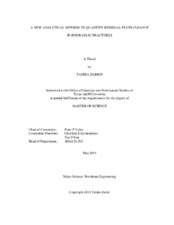| dc.description.abstract | A number of factors contribute to reduce the production benefits from hydraulic fracturing, including inefficient fluid design, poor proppant selection and or, the inability of fracture fluid to degrade and flow back after treatment. Undegraded hydraulic fracturing fluid has always been a major issue, and is believed to drastically undermine the performance of hydraulically fractured wells. Several attempts have been made to quantify the damage associated with residual fluid, with varying level of success. Previous approaches may include lab experiments, numerical simulation and evaluation of production data. In this work, the previous investigation results has been accounted and further improvement is made in quantifying the cleanup of residual fluid and subsequent hydrocarbon recovery. After investigating fracture fluid damage mechanism, a simple mathematical model is developed to quantify residual fluid cleanup and its effect on the gas production from a tight gas sandstone reservoir. Key solutions have been derived with the help of Mathematica, and then a simple Excel-VBA code have also been developed to better characterize the cleanup process under different reservoir conditions, hydraulic fracture dimensions and varying residual fluid rheology.
Contrary to the previous attempts we assume that the entire fracture is in a plugged initially. In addition to this we use a system approach and show that initially the available reservoir energy is used for establishing a narrow flow channel in the fracture, and the system approaches to its final productivity gradually. Results and analyses show that higher conductivity of hydraulic fracture does not ensure 100% cleanup; if sufficient energy is not available from the reservoir to overcome the resistance exhibited by the complex rheology of residual fluid along the fracture.
This work provides a methodology that will help engineers to select the right fracturing fluid properties in tight gas. This is important because only in North America approximately 10,784Tcf of unconventional and gas reserves are present and more such reservoirs will be stimulated to fulfill the needs of future energy demand. | en |


